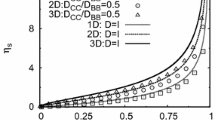Abstract
Diffusion-controlled precipitation in isothermal ternary systems of arbitrary constitution is analyzed theoretically. The treatment is applicable to isolated precipitates whose morphology is preserved during growth;i.e., planar surfaces, cylinders, spheres, spheroids, and ellipsoids. The analysis does not account for ternary diffusional interaction. For a particular bulk alloy composition, the problem is essentially to determine the precipitatematrix interface velocity and the phase diagram tie-line which defines the equilibrium concentrations at this interface. The concepts of interface composition and interface velocity contours on the ternary phase diagram are introduced as instruments for solution of this problem. The influence on these contours of various diffusivity ratios for the independent components and of precipitate morphology is investigated. The assumption that local equilibrium maintains at the precipitate-matrix interface is critically examined and it is suggested that there are many instances in which the assumption is invalid. Therefore, Hultgren’s concept of paraequilibrium is discussed and is incorporated into the present theoretical framework. The techniques developed in the analysis are applied to ferrite growth in the Fe-C-Mn system.
Similar content being viewed by others
References
A. Hultgren:Trans. ASM, 1947, vol. 39, p. 915.
A. Hultgren:Jemkontorets Ann., 1951, vol. 135, p. 403.
M. Hillert: Internal Rep., Swedish Inst. Metal Research, 1953.
M. Hillert: inThe Mechanism of Phase Transformations in Crystalline Solids, edited by Inst. of Metals, Inst. of Metals, London, p. 231, 1969.
J. S. Kirkaldy:Can. J. Phys., 1958, vol. 36, p. 907.
L. S. Darken:Trans. TMS-AIME, 1961, vol. 221, p. 654.
G. R. Purdy, D. H. Weiche, and J. S. Kirkaldy:Trans. TMS-AIME, 1964, vol. 230, p. 1025.
H. I. Aaronson, H. A. Domain, and G. M. Pound:Trans. TMS-AIME, 1966, vol. 236, p. 768.
H. I. Aaronson and H. A. Domain:Trans. TMS-AIME, 1966, vol. 236, p. 781.
J. B. Gilmour, G. R. Purdy, and J. S. Kirkaldy:Met. Trans., in press.
F. S. Ham:Quart. Appl. Math., 1959, vol. 17, p. 137.
G. Horvay and J. W. Cahn:Acta Met, 1961, vol. 9, p. 695.
F. C. Frank:Proc. Roy. Soc, 1950, vol. A201, p. 586.
C. Zener:J. Appl. Phys., 1949, vol. 20, p. 950.
M. Abramowitz and I. A. Stegun: eds.,Handbook of Mathematical Functions, National Bureau of Standards, Washington, 1964.
M. Hone, S. V. Subramanian, and G. R. Purdy:Can. Met. Quart., 1969, vol. 8, p. 251.
E. Rudberg:Jerkontorets Ann., 1952, vol. 136, p. 91.
M. Hillert:ActaMet., 1961, vol. 9, p. 525.
J. W. Cahn:Acta Met., 1961, vol. 9, p. 795.
K. R. Kinsman and H. I. Aaronson: inTransformation and Hardenability in Steels, edited by Climax Molybdenum, p. 39, Ann Arbor, 1967.
Author information
Authors and Affiliations
Rights and permissions
About this article
Cite this article
Coates, D.E. Diffusion-controlled precipitate growth in ternary systems I. Metall Trans 3, 1203–1212 (1972). https://doi.org/10.1007/BF02642453
Received:
Issue Date:
DOI: https://doi.org/10.1007/BF02642453




